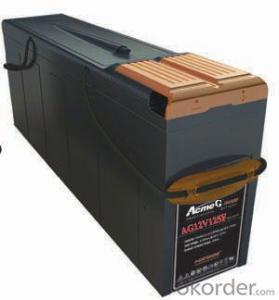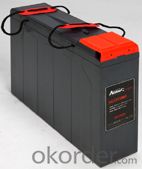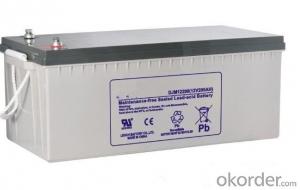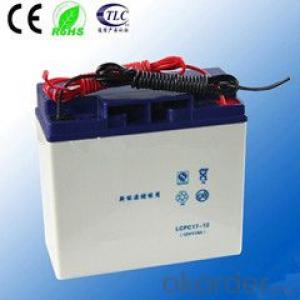Gel Battery the AcmeG Series Battery AG12V125F
- Loading Port:
- Shanghai
- Payment Terms:
- TT OR LC
- Min Order Qty:
- 2000 unit
- Supply Capability:
- 400000 unit/month
OKorder Service Pledge
OKorder Financial Service
You Might Also Like
Range summary
The AcmeG range front access gel batteries is designed based on the Acme series, using the polymer gel electrolyte with real front access structure. The state-of the-art internal and external design ensures AcmeG the high reliability and makes the installation quite simple and safe when placed on a standard relay rack tray or in a closed cabinet. AcmeG range gel battery is designed with high energy density and suitable for 19". 23" rack or cabinet.
Technical features
Long life
Using the polymer gel electrolyte
4BS paste technology
Special paste formula
Special patented grid alloyWide operational temperature range
Excellent charging and discharging ability at low temperature
Decline the water-loss at high temperaturespecial structure
real front access structure makes the installation and maintenance squite simple and safe
suitable for 19". 23" rack or cabinet
The specially centralized venting system ensures the small gas be vented our of the closed cabinet
Type: | AG12V125F | |
Voltage: | 12V | |
Nominal Capacity: | 125Ah(C10) | 125Ah(10 hours rate:) |
Length: | 558mm | |
Width: | 125mm | |
Height: | 270mm | |
Height with termial: | 270mm | |
Weight: | 46Kg |
Compliant standards
Designed to be compliant with:
IEC 60896-2
BS 6290 Part 4
Telcordia SR-4228
EUROBAT GUIDE
UL
Manufactured under system ISO9001 & ISO14001 by NARADA
Battery installation compliant with:
EN 50272-2 or local equivalents
Main applications
Telecom standby and cyclical applications
UPS
Power plant and power transfer system
Solar energy system
Emergency lighting system
Products characteristics:
float voltage: 2.25Vpc at 77oF(25oC) , Equalization charge voltage: 2.40Vpc at 77oF(25oC)
Self discharge rate: < 2% pre month at 68oF(20oC)
Design life: more than 12 years at 68oF(20oC)
Shelf life: 6 months at 68oF(20oC)
Recombination efficiency: >99%
the Pressure at which the valve opens & reclose is Opened at 10 to 35kpa(1.45psi to 5.08psi) and
closed at 3 to 15 kpa (0.44psi to 2.18psi)
Temperature ranges: -40oC to 50oC
Terminal Hardware Torque:10±0.1N m
Container Material: ABS (V0 optional)
FAQ
![]() What is a Gel Cell Battery?
What is a Gel Cell Battery?
A gel battery design is typically a modification of the standard lead acid automotive or marine battery. A gelling agent is added to the electrolyte to reduce movement inside the battery case. Many gel batteries also use one way valves in place of open vents, this helps the normal internal gasses to recombine back into water in the battery, reducing gassing. "Gel Cell" batteries are non-spillable even if they are broken. Gel cells must be charged at a lower voltage (C/20) than flooded or AGM to prevent excess gas from damaging the cells. Fast charging them on a conventional automotive charger may be permanently damage a Gel Battery.
![]() What is sulfation of batteries?
What is sulfation of batteries?
Sulfation is the formation or deposit of lead sulfate on the surface and in the pores of the active material of the batteries' lead plates. If the sulfation becomes excessive and forms large crystals on the plates, the battery will not operate efficiently and may not work at all. Common causes of battery sulfation are standing a long time in a discharged condition, operating at excessive temperatures, and prolonged under or over charging.
![]() How long a battery can last?
How long a battery can last?
The service design life of a battery are vary considerably with how it is used, how it is maintained and charged, temperature, and other factors.
![]() Do batteries self-discharge when not in use?
Do batteries self-discharge when not in use?
All batteries, regardless of their chemistry, self-discharge. The rate of self-discharge depends both on the type of battery and the storage temperature the batteries are exposed to. However, for a good estimate, Narada batteries self-discharge approximately 4% per week at 80ĄăF.
- Q: How to repair the battery?
- Maintain the battery before, first of all to clean up the battery appearance of the dust, remove the terminal above the stain and corrosion.
- Q: How to determine the battery is good or bad?
- General side maintenance has an observation hole if it is green to prove that the battery is normal if it is black to prove that the battery does not save electricity. There is to observe whether there is liquid exudation, if any, proved to be bad. Finally, you can touch the hand, such as feeling the battery around the plane has proved proof bad.
- Q: What battery does the van use?
- The battery is mainly composed of tube positive plate, negative plate, electrolyte, separator, battery compartment, battery cover, pole, injection liquid cover and so on. The electrode of the exhaust type battery is made of lead and lead oxide, and the electrolyte is an aqueous solution of sulfuric acid. The main advantage is the voltage stability, the price is cheap; the disadvantage is lower than the energy (that is, per kilogram of battery storage power), short life and routine maintenance frequently. Old ordinary battery life of about 2 years, and the need to regularly check the height of the electrolyte and add distilled water. However, with the development of science and technology, lead-acid battery life becomes longer and maintenance is also more simple.
- Q: What are the advantages of maintenance-free batteries?
- Maintenance-free battery because of its normal charging voltage, the electrolyte only produce a small amount of gas, so throughout the use of the need for the addition of distilled water, in the normal charging system, do not need to remove the charge from the removal. But in the maintenance of the proportion of its electrolyte should be checked.
- Q: What is the meaning of the battery above 12v65Ah?
- Voltage 12V, current 65AH, that is the capacity of 65A. (A is the unit of current. H is the time unit)
- Q: 80ah how much battery storage capacity?
- The size of the battery storage power refers to the battery capacity. Battery capacity is generally calculated in AH (safety). You 80Ah battery capacity is 80Ah, meaning that if you discharge current to 80A, you can put an hour.
- Q: The role of the battery?
- Battery is widely used, can be used for ups, electric cars, scooters, cars, wind energy solar systems, security, and so on.
- Q: What kind of battery is divided into?
- Ordinary battery: ordinary battery plate is composed of lead and lead oxide, the electrolyte is sulfuric acid aqueous solution. Its main advantage is the voltage stability, the price is cheap.
- Q: What is a maintenanceable battery?
- It also has a shock, high temperature, small size, self-discharge characteristics. Life is generally twice the ordinary battery.
- Q: How does battery activation work?
- Always keep the battery surface clean. Found that the surface of dust and acid, it should be timely wipe, wipe can be wiped with soda water wipes wipe again, after rinse with water.
Send your message to us
Gel Battery the AcmeG Series Battery AG12V125F
- Loading Port:
- Shanghai
- Payment Terms:
- TT OR LC
- Min Order Qty:
- 2000 unit
- Supply Capability:
- 400000 unit/month
OKorder Service Pledge
OKorder Financial Service
Similar products
Hot products
Hot Searches
Related keywords


























